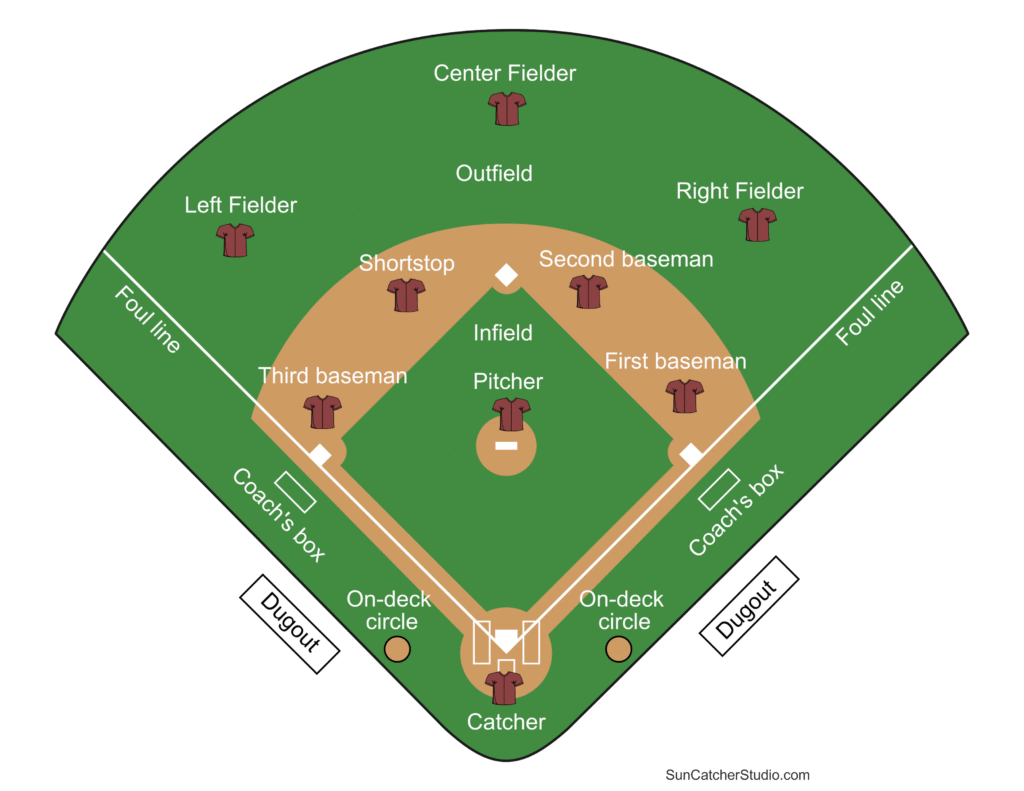Base ball is more than just a game; it’s a carefully choreographed balance of athletic skill, mental toughness, and team coordination. While the basic premise is to score more runs than the opponent, there’s a lot more going on behind each pitch, swing, and run. Whether you’re a fan, player, or just curious, this detailed guide will walk you through how base ball works, from its structure and rules to the strategy that makes it “America’s pastime.”

The Base Ball Field: Shape, Layout & Dimensions
A base ball field is shaped like a diamond and split into two major areas: the infield and outfield. The infield includes four bases arranged in a square, while the outfield fans out behind the bases. The distance between bases is typically 90 feet in professional play source.
The pitcher’s mound is located at the center of the diamond and is exactly 60 feet 6 inches from home plate source. Outfield fence distances vary by stadium, often between 320 to 400 feet from home plate.
These measurements aren’t arbitrary—they shape how the game is played and how strategies are implemented. Fielders and batters alike adjust their positions and techniques based on the dimensions of the field source.
Base Ball Rules: The Basics
The game of base ball is divided into nine innings, with each team getting a turn to bat (offense) and field (defense). Each half-inning ends after the fielding team records three outs.
Key rules include:
- Strikes and Balls: A batter is out after three strikes. Four balls, meaning pitches outside the strike zone that the batter doesn’t swing at, result in a walk to first base.
- Fair and Foul Balls: Balls hit inside the baselines are considered fair, while others are foul. Only fair balls allow runners to advance.
- Scoring a Run: A run is scored when a player safely rounds first, second, third, and touches home plate before three outs are recorded.
These fundamentals are governed by detailed official rules, which even dictate how a batter’s stance or a pitcher’s wind-up should be executed.
You can also read about Rules of Soccer
Positions and Player Roles on the Field
A base ball team consists of nine players, each with a defined position and responsibility on the field. These roles require unique athletic skills and contribute to the team’s defensive setup.

Pitcher (P)
Often the most critical player, the pitcher stands on the mound and aims to outwit batters using a mix of pitches—fastballs, curveballs, sliders, and changeups. The goal is to disrupt the batter’s timing source.
Catcher (C)
Positioned behind home plate, the catcher not only receives pitches but also calls the game by signaling pitch types and locations. A strong catcher understands both the pitcher’s strengths and the batter’s weaknesses source.
Infielders
- First Baseman (1B): Catches throws and fields ground balls near first base.
- Second Baseman (2B) and Shortstop (SS): Collaborate for double plays and cover a lot of ground between bases.
- Third Baseman (3B): Needs quick reflexes for hard-hit balls and makes long throws to first source.
Outfielders
- Left, Center, and Right Fielders: Cover fly balls and stop extra-base hits. The center fielder typically has the best range and arm strength source.
Each position on the base ball field is essential and requires a combination of skill, coordination, and awareness source.
Offensive Strategy: Scoring Runs
The goal of the offensive team is to get runners on base and bring them home to score. But this takes more than just hitting the ball.
Batting Order
The lineup is arranged so that the strongest hitters (typically third and fourth in the order) can drive in runners who get on base early.
Base Running Tactics
- Base Stealing: A runner attempts to advance while the pitcher is delivering the ball.
- Hit-and-Run: A coordinated play where the runner takes off as the batter swings.
- Sacrifice Bunt/Hit: The batter purposely gives up their at-bat to move a runner closer to scoring source.
Situational awareness is key. Runners must gauge when to take an extra base, and batters must adjust based on the count and game situation source.
Defensive Strategy: Outs and Field Positioning
Defense in base ball isn’t just about catching the ball—it’s a tactical exercise involving positioning, pitch selection, and coordination.
Pitching as Strategy
Pitchers use different pitch types and speeds to confuse batters. For example, a fastball followed by a change-up may force a mistimed swing source.
Positioning and Shifts
Teams use defensive shifts to counter specific batters’ tendencies. If a batter always hits to right field, more defenders may shift to that side source.
Team Communication
Cut-off plays, rundown drills, and bunt defense all require flawless communication between fielders source (PDF).
More advanced teams also rely on predictive analytics and data-driven scouting reports to plan their in-game decisions source (PDF).
Specialized Roles and Game Officials
In addition to standard fielders, some special roles and individuals impact the game’s flow and fairness.
Designated Hitter (DH)
In leagues that use the DH rule (like MLB’s American League), one player bats in place of the pitcher but does not field. This allows for more offensive production.
Relief Pitchers
As games progress, starting pitchers may be replaced with relief pitchers, who include:
- Closers: Used in the final inning to secure a win.
- Setup Men: Pitch the eighth inning to hold a lead.
- Middle Relievers: Fill the gap between the starter and the closer.
Umpires
Umpires enforce the rules and make judgment calls on pitches, plays at bases, and scoring. The home plate umpire controls the strike zone and overall game pace.
You can also read about History of Sports
Final Thoughts
Base ball is a sport steeped in tradition but constantly evolving. While the objective is simple—score more runs than the opponent—the strategies and nuances make it endlessly complex and enjoyable. By understanding its rules, roles, and strategic elements, fans and players alike can appreciate the brilliance and unpredictability of every inning.
Whether you’re watching your first game or stepping onto the diamond, base ball offers a unique blend of intellect, skill, and emotion unmatched by any other sport.

Pingback: Tennis Scoring System